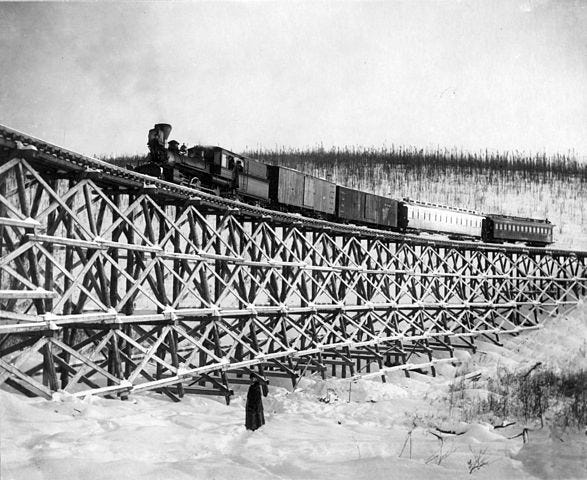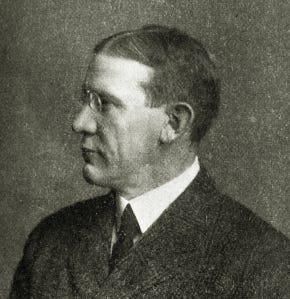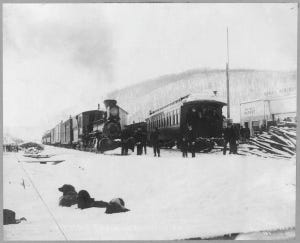Excerpted from:
The Alaska Railroad: 1902-1923, Blazing an Iron Trail Across The Last Frontier, by Helen Hegener, published in May, 2017 by Northern Light Media. 400 pages, over 100 b/w historic photos, maps, bibliography, indexed. The book can be ordered via PayPal for $24.00 plus $5.00 postage, by clicking here (credit cards accepted). The Alaska Railroad: 1902-1923 is also available at Amazon, IndieBound, and can be ordered through your favorite bookstore.
“Perhaps more than anyone else, Falcon Joslin and his Tanana Valley Railroad set the stage for the economic growth and ultimate survival of Fairbanks.”
National Register of Historic Places form, 1980
Falcon Joslin was a man of vision. Born in Bellview, Tennessee in 1866, he became a lawyer, practicing in Seattle, Washington from 1890 until the Klondike Gold Rush took him north in 1898. He hung out his shingle in Dawson City, but when word of a new strike in the Tanana Valley reached Dawson in 1904, Joslin joined the rush of miners who traveled down the Yukon River to the Alaskan prospect.
Surveying the increasing number of prospectors, miners, and the businessmen who followed them, and seeing teamsters paid outlandish wages for freighting supplies to the mines north of Fairbanks, Joslin recognized that the mining camps in the recently established Fairbanks Mining District needed a means of cheap and reliable transportation, which could be provided by a railroad.
Joslin also noted great agricultural potential in the fertile Tanana Valley, and envisioned farming as a means of diversifying and stabilizing the economic base of interior Alaska. Farming would also be greatly benefitted by a rail line, and so the far-sighted Joslin set to work.
Falcon Joslin’s dreams were as big as his new homeland, for he envisioned a network of railroads spanning the territory, and reaching from the port town of Haines, on the Lynn Canal in southeastern Alaska, passing through the interior Tanana Valley and stretching westward to Nome on the Bering Sea.
His initial project, which became the Tanana Valley Railroad, was planned as a rail line reaching north and east to Circle City on the Yukon River, at that time the center of the Circle Mining District and the landing for steamboats heading upriver to the town of Eagle, or to Dawson City in the Yukon Territory, or downriver to Nenana, Ruby, Nulato, and St. Michael on Norton Sound, and the Bering Sea.
The small town of Chena, at the confluence of the Chena and Tanana Rivers and the head of steamboat navigation on the Tanana, became the southern terminus of Joslin’s railroad. From Chena the tracks wound in a northeasterly direction, through the gold mining camps north of the present-day Fairbanks, including the communities of Fox, Gilmore, and Olnes, and ended at Chatanika, a gold mining camp on the river of the same name, founded in 1904. The original destination, Circle City, was still 130 miles away and over two daunting mountain passes.
The progression of the Tanana Valley Railroad, originally called the Tanana Mines Railway, is described in Howard Clifford’s Rails North (Superior Publishing Company, 1982): “The railroad was built in two stages. In 1905, the road was put in from Chena to Gilmore on Pedro Creek, with a spur of 4.7 miles to Fairbanks, which started operating in September, 1905. The next year, this 26-mile section of line was considerably improved. In 1907, the six-month working season brought an extension of the line, now called the Tanana Valley Railroad, to Chatanika.”
Clifford noted the “considerable obstacles” overcome by Joslin and his associates in building the railroad, including periodic flooding of the low land near Chena, which necessitated trestles several hundred feet in length, and the costs of transporting the 30-pound rails and equipment as much as 6,000 miles. Laborers were paid as much as $7.50 per day, an extraordinary amount for the time but needed to keep men from departing for the nearby gold fields.
The construction costs, including surveys, preliminary work, and equipment, came to $815,969.05, and other than a five-year dispensation of the federal tax, the railroad was built entirely without any government subsidy, a rarity for the time.
A golden spike ceremony was held in the summer of 1905, highlighted by a speech from Federal District Judge James Wickersham, and Falcon Joslin was hailed as the “Harriman of the North,” after the railroad magnate E. H. Harriman, who, at the time of his death, controlled the Union Pacific Railroad, the Southern Pacific Railroad, the Illinois Central Railroad, the Pacific Mail Steamship Company, and the Wells Fargo Express Company, among others.
During its heyday the Tanana Valley Railroad was a successful part of interior Alaska’s transportation network, meeting riverboats and barges at Chena, on the Tanana River, during the summer months, from May until October; and during the winter months providing a link for passengers and freight arriving via dog team and horse-drawn sledge from Cordova and Valdez, on Prince William Sound, over the Valdez-to-Fairbanks Trail.
In Rails North, Howard Clifford notes, “It must not be overlooked that, although not a moneymaker, the Tanana Valley’s service to the gold creeks was important. On weekdays, the railroad brought passengers, fuel, and supplies. Sometimes on Sundays and holidays excursions were offered at bargain rates to sightseers.”
An early advertisement for the Tanana Valley Railroad offers “Three Trains Daily Between Fairbanks and The Creeks,” and names the stops of Chena, Ester, Happy, Eldorado, Engineer, Goldstream, Pedro, Dome, Vault, Little Eldorado, Chatanika, and Cleary Creek. It also notes that “Passenger and freight stages operated by the Company connect all trains,” which allowed transportation from the rails to nearby facilities.
As Fairbanks eclipsed Chena as the business hub of interior Alaska, the little railroad’s headquarters moved to a spacious railroad depot and terminal on Garden Island. It was these Fairbanks terminal facilities, along with the right-of-way between Chena and Fairbanks held by Joslin’s railway, which interested the Alaskan Engineering Commission in 1917. The rail line was leased, and later sold, to the government as the northern terminus of what would become the Alaska Railroad. ~•~
Excerpted from:
The Alaska Railroad: 1902-1923, Blazing an Iron Trail Across The Last Frontier, by Helen Hegener, published in May, 2017 by Northern Light Media. 400 pages, over 100 b/w historic photos, maps, bibliography, indexed. The book can be ordered via PayPal for $24.00 plus $5.00 postage, by clicking here (credit cards accepted). The Alaska Railroad: 1902-1923 is also available at Amazon, IndieBound, and can be ordered through your favorite bookstore.










